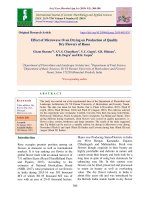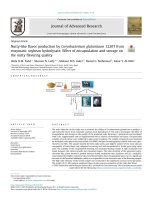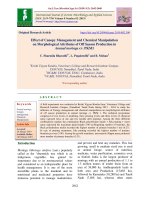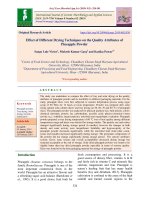Effect of microwave oven drying on production of quality dry flowers of roses
Bạn đang xem bản rút gọn của tài liệu. Xem và tải ngay bản đầy đủ của tài liệu tại đây (235.98 KB, 9 trang )
Int.J.Curr.Microbiol.App.Sci (2019) 8(2): 300-308
International Journal of Current Microbiology and Applied Sciences
ISSN: 2319-7706 Volume 8 Number 02 (2019)
Journal homepage:
Original Research Article
/>
Effect of Microwave Oven Drying on Production of Quality
Dry Flowers of Roses
Gitam Sharma1*, S.V.S. Chaudhary1, Y.C. Gupta1, S.R. Dhiman1,
R.K. Dogra2 and R.K. Gupta3
1
Department of Floriculture and Landscape Architecture, 2Department of Fruit Science,
Department of Basic Sciences, Dr YS Parmar University of Horticulture and Forestry
Nauni, Solan 173230 Himachal Pradesh, India
3
*Corresponding author
ABSTRACT
Keywords
Value addition, Dry
flower, Dry roses,
Silica gel,
Microwave oven
Article Info
Accepted:
04 January 2019
Available Online:
10 February 2019
The study was carried out at the experimental farm of the Department of Floriculture and
Landscape Architecture, Dr YS Parmar University of Horticulture and Forestry, Nauni,
Solan. The data was taken for four flushes, that is, Flush I (November, 2017), Flush II
(April, 2018), Flush III (June, 2018) and Flush IV (August, 2018). The cultivars selected
for the experiment were Avalanche, Confetti, Corvette, First Red, Gavanna, Gold Strike,
Hollywood, Nobelesse, Peach Avalanche, Sweet Avalanche, Taj Mahal and Tineke. After
giving different drying treatments, dried flowers were scored on quality parameters i.e.
flower colour, texture, brittleness and shape retention. The results of the study suggested
that Taj Mahal can be used as a suitable cultivar for drying in Microwave oven during
November (Flush I) and April (Flush II) flushes and Corvette during June (Flush III) and
August (Flush IV) flushes.
Major rose Producing States/Districts in India
are West Bengal, Karnataka, Gujarat,
Chhattisgarh and Maharashtra. Fresh rose
flowers though exquisite in their beauty are
highly perishable and delicate in nature and
cannot retain their beauty and fresh look for a
long time in spite of using best chemicals for
enhancing vase life. In this context rose
flowers can be dried, preserved and processed
to retain its beauty as well as everlasting
value. The dry flower industry in India is
about fifty years old and was introduced by
the British. India stands fourth in dry flower
Introduction
Rose occupies premier position among cut
flowers in domestic as well as international
markets. It is top ranking cut flower in the
global flower trade with an annual turnover of
731 million Euros (Royal FloraHolland Facts
and Figures, 2017). According to the
estimates of National Horticulture Board
(NHB, 2017), total production of cut flowers
in India during 2015-16 was 593 thousand
MT of which 301.95 thousand MT was of
rose with an area of 29.41 thousand hectare.
300
Int.J.Curr.Microbiol.App.Sci (2019) 8(2): 300-308
exports worldwide. Potpourris being the
major segment of drying flower industry
valuing at Rs. 55 crores in India alone
(Nirmala et al., 2008). In recent floriculture
trade, the export of dry flowers from India
during 2013-2014 was Rs. 363.3 crores
(Periban et al., 2014). Indian export of
flowers is composed of 71% dry flowers
exported mainly to USA, Japan, Australia,
Russia and Europe (De et al., 2016). As rose
is one of the top ranking cut flowers in the
international flower trade, dry cut flowers of
roses are the most expensive and exquisite of
all dried flowers traded in the international
market (Barnett and Moore, 1999). Keeping
in view the above facts, the present study was
planned to find out the suitability of different
cultivars of rose to be used as dry flower.
laboratory to give various treatments. The
leaves present on each cut stem were removed
before using them for drying. Plastic
containers were selected for drying. They
were filled evenly with the silica gel upto 4
inches of height. Depressions were made to
insert the selected cut flowers into the
medium. After inserting the flowers, the
media was poured gently for uniform
covering of the petals without deforming the
petals. The media was evenly distributed so as
to equalize the pressure on all sides of the
flower. After inserting the flowers in the
media, they were placed in the Microwave
oven for the specified exposure durations i.e.,
2 minutes, 2.5 minutes and 3 minutes. The
containers were removed after the treatment
and were kept as such for 48 hours without
removing the flowers from the media. After
drying, the embedded flowers were taken out
carefully by tilting the containers. The flowers
were rolled down and were collected. They
were tapped by holding it from the stalk to
remove the excess desiccant material. Petals
were also gently brushed with soft camel hair
brush to remove the desiccant completely so
that the original colour of the dried flower
could be seen. After giving different drying
treatments, dried flowers were scored on
following quality parameters i.e. flower
colour, texture, brittleness and shape
retention. A scale was developed and scores
were given based on 5 points for each
parameter as per the score card given in Table
1. Statistical analysis was carried out using
Completely Randomized Design (Factorial).
Materials and Methods
The study was carried out at the experimental
farm of the Department of Floriculture and
Landscape Architecture, Dr YS Parmar
University of Horticulture and Forestry,
Nauni, Solan. The data was taken for four
flushes, that is, Flush I (November, 2017),
Flush II (April, 2018), Flush III (June, 2018)
and Flush IV (August, 2018). The
experimental farm is located 1276 m above
mean sea level at the latitude of 32°51′0″ N
and
longitude
of
77°11′30″E.
The
experimental material consisted of twelve
Hybrid Tea (H.T.) Rose varieties obtained
from KSG Sons, Bangalore. The cultivars
selected for the experiment were Avalanche,
Confetti, Corvette, First Red, Gavanna, Gold
Strike, Hollywood, Nobelesse, Peach
Avalanche, Sweet Avalanche, Taj Mahal and
Tineke (Plate 1). Healthy, disease free and
uniform flower stem were harvested at half
bloom stage (half bloom stage referred to the
stage wherein 50% of the petals were open)
(Safeena et al., 2006) in the afternoon when
the moisture over the flowers dried and
immediately after harvesting, they were put in
water. They were then brought to the
Results and Discussion
Quality parameters during
(November, 2017) (Plate 2)
flush
I
Scoring of dried cultivars is very important to
assess their quality, therefore a score card was
developed and cultivars were scored
accordingly as presented in Table 2.
301
Int.J.Curr.Microbiol.App.Sci (2019) 8(2): 300-308
During Flush I, maximum score (16.84) was
alloted to Nobelesse cultivar of rose which
was found to be statistically at par with
Confetti (15.77), Corvette (13.92), First Red
(14.09), Gavanna (16.20), Gold Strike (14.73)
and Taj Mahal (16.33). Whereas, minimum
score (7.58) for quality parameters was
alloted to Hollywood which was found to be
statistically at par with Tineke (10.62).
3 minutes exposure time which was found to
be statistically at par with Confetti (17.07),
Corvette (15.44), First Red (15.83), Gavanna
(15.43), Nobelesse (15.07) and Taj Mahal
(17.00) dried at 2 minutes exposure time,
Confetti (15.51), Corvette (16.17), First Red
(15.43), Gavanna (14.33), Nobelesse (14.70)
and Taj Mahal (15.77) dried at 2.5 minutes
exposure time and Confetti (16.17), Gavanna
(16.03) and Taj Mahal (16.71) dried at 3
minutes exposure time.
Among exposure times, maximum score
(14.65) was given to cultivars dried at 2
minutes exposure time which was found to be
statistically at par with cultivars dried at 2.5
minutes exposure time. However, minimum
score (12.55) was obtained by cultivars dried
at 3 minutes exposure time.
However, minimum score (4.71) was obtained
by Peach Avalanche dried at 3 minutes
exposure time which was found to be
statistically at par with Hollywood (8.45)
dried at 2 minutes exposure time, Avalanche
(6.43), Corvette (8.37), Sweet Avalanche
(7.23) and Tineke (8.43) dried at 3 minutes
exposure time.
Interaction of cultivars and exposure time was
found to be non significant.
Interaction between cultivars and different
time levels in microwave oven for quality
parameters was found to be significant in the
study by Safeena and Patil (2013) where
overall acceptability was high for flowers of
cv. ‘Lambada’ dried for 2.5 minutes in the
microwave oven. This study confirms our
finding too.
Quality parameters during flush II (April,
2018) (Plate 3)
During Flush II, maximum score (16.49)
among different cultivars was observed in Taj
Mahal which was found to be statistically at
par with Confetti (16.25), Gavanna (15.27)
and Nobelesse (16.05). Whereas, minimum
score (9.22) was obtained by Hollywood
which was found to be statistically at par with
Avalanche (9.66), Gold Strike (11.63), Peach
Avalanche (9.65), Sweet Avalanche (9.94)
and Tineke (10.74) (Table 3).
Quality parameters during flush III (June,
2018) (Plate 4)
Maximum score (15.86) during Flush III was
observed in First Red which was found to be
statistically at par with Confetti (14.19) and
Corvette (14.64). However minimum score
(9.40) was observed in Gavanna which was
found to be statistically at par with Peach
Avalanche (10.17) (Table 4).
Among exposure times, maximum score
(13.76) was observed in cultivars dried at 2
minutes exposure time which was found to be
statistically at par with those dried at 2.5
minutes exposure time. However, minimum
score (11.68) for quality parameters was
observed in 3 minutes exposure time.
Exposure times were found to be statistically
non significant for different cultivars of rose
during Flush III. Interaction of cultivars and
exposure time was also found to be non
significant.
Interaction of cultivars and exposure time
showed that maximum score (18.37) was
obtained by Nobelesse cultivar when dried at
302
Int.J.Curr.Microbiol.App.Sci (2019) 8(2): 300-308
Quality parameters during
(August, 2018) (Plate 5)
flush
Flush I, Confetti (16.25), Gavanna (15.27),
Nobelesse (16.05) and Taj Mahal (16.49)
during Flush II, Corvette (14.64) and First
Red (15.86) during Flush III and Corvette
(15.51) and First Red (14.50) during Flush
IV. However, minimum score (7.58) was
observed in Hollywood during Flush I which
was found to be statistically at par with
Avalanche (9.66), Hollywood (9.22), Peach
Avalanche (9.65) and Sweet Avalanche (9.94)
during Flush II, Gavanna (9.40) during Flush
III and Gavanna (7.65) and Peach Avalanche
(8.12) during Flush IV.
IV
During Flush IV, maximum score (15.51) was
obtained by Corvette which was found to
statistically at par with First Red (14.50),
whereas, minimum score (7.65) was observed
in Gavanna which was found to be
statistically at par with Peach Avalanche
(8.12) (Table 5).
Among exposure times, maximum score
(13.20) was observed for cultivars dried at 2
minutes exposure time and minimum (10.64)
for cultivars dried at 3 minutes exposure time.
Safeena and Patil (2013) reported significant
difference due to different time levels, in
which power output level for 2.5 minutes
scored the highest points for colour,
appearance and texture in rose cultivars. The
flowers dried for 3 minutes scored the least
for colour and for appearance thereby
indicating failure to retain the original
appearance after drying. According to them,
among different time levels, subjecting the
flowers to power output level for 2.5 minutes
was found to be the best for drying of Dutch
roses. Treating the flowers at this power
output level was best with respect to colour,
appearance and texture. Upon subjecting to
longer duration of drying (3 minutes), the
texture and colour retainment was poor. These
results are in conformity with our results
where drying at 2 minutes in microwave oven
obtained maximum score and drying at higher
time, i.e., 3 minutes resulted in minimum
score. Increase in the temperature might have
been the cause for poor colour.
Interaction of cultivars and exposure time was
found to be non significant.
Pooled effect of flushes
parameters (Plate 6)
on
quality
Pooled data of all the flushes in Table 6
showed that in general, Taj Mahal scored
maximum score (15.61) with respect to
quality parameters which was found to be
statistically at par with Confetti (15.57),
Corvette (15.07), First Red (15.03) and
Nobelesse (14.43). However, minimum score
(10.79) for quality parameters was observed
in Hollywood which was found to be
statistically at par with Avalanche (11.81),
Peach Avalanche (11.09) and Sweet
Avalanche (11.57).
In general, among the flushes, maximum
score (13.70) was observed in Flush I and
minimum (11.90) in Flush IV which was
found to be statistically at par with Flush III.
Dhatt et al., (2007) dried rose buds in
microwave oven for 3, 4 and 5 minutes,
respectively, and found that rose buds dried
for 4 min exhibited good colour and good
shape retention. Biswas and Dhua (2010)
performed an experiment on microwave oven
drying of cut Carnation varieties viz., Kristina
and Cano. These were harvested at fully
Interaction of cultivars and flushes show that
maximum score (16.84) was observed in
Nobelesse cultivar of rose during Flush I
which was found to be statistically at par with
Confetti (15.77), Gavanna (16.20), Gold
Strike (14.73) and Taj Mahal (16.33) during
303
Int.J.Curr.Microbiol.App.Sci (2019) 8(2): 300-308
opened stage and then subjected to drying
treatments in microwave oven (1200 watt)
after embedding them in silica gel (desiccant)
for 2 to 4 minutes.
of 3 or 4 minutes which is true for our study
also.
Among the four different cultivars evaluated
by Safeena and Patil (2013), dry flowers of
‘Lambada’ scored maximum points with
respect to retention of colour, appearance and
texture whereas least score of points for
colour, appearance and texture was recorded
in ‘Ravel’.
The quality of dried flowers deteriorated more
with increase in the drying duration and the
lowest drying duration of 2 minutes showed
the best results in both varieties with respect
to appearance, colour, shape and sizes of
dried flower as compared to drying duration
Table.1 Score card for different quality parameters of dried flowers
Colour
Excellent
Very
Good
Good
Poor
Very Poor
5
4
3
2
1
Texture
Smooth 5
Medium 3
Rough
Brittleness
Intact
5
Slightly 3
brittle
Brittle
1
1
Shape retention
Excellent 5
Very
4
Good
Good
3
Poor
2
Very Poor 1
Table.2 Effect of exposure time (E) on quality parameters of rose cultivars dried in microwave
oven during Flush I (November, 2017) (score out of 20)
Exposure time 2 mins
Cultivars
15.81
Avalanche
15.10
Confetti
13.87
Corvette
17.10
First Red
18.07
Gavanna
13.80
Gold Strike
8.39
Hollywood
17.43
Nobelesse
16.83
Peach Avalanche
13.10
Sweet Avalanche
17.48
Taj Mahal
8.77
Tineke
Mean
14.65
CD0.05
Cultivars: 3.07
Exposure time: 1.53
Cultivars X Exposure time: NS
2.5 mins
3 mins
Mean
11.10
17.77
15.10
12.80
17.40
17.33
7.15
15.70
12.87
13.07
13.43
13.07
13.90
14.17
14.43
12.80
12.37
13.13
13.07
7.18
17.40
10.85
7.08
18.07
10.03
12.55
13.69
15.77
13.92
14.09
16.20
14.73
7.58
16.84
13.52
11.08
16.33
10.62
304
Int.J.Curr.Microbiol.App.Sci (2019) 8(2): 300-308
Table.3 Effect of exposure time (E) on quality parameters of rose cultivars dried in microwave
oven during Flush II (April, 2018) (score out of 20)
Exposure time
Cultivars
Avalanche
Confetti
Corvette
First Red
Gavanna
Gold Strike
Hollywood
Nobelesse
Peach Avalanche
2 mins
2.5 mins
3 mins
Mean
12.47
17.07
15.44
15.83
15.43
11.03
8.45
15.07
13.74
10.08
15.51
16.17
15.43
14.33
11.09
9.80
14.70
4.71
6.43
16.17
8.37
9.77
16.03
12.77
9.40
18.37
10.50
9.66
16.25
13.33
13.68
15.27
11.63
9.22
16.05
9.65
10.20
Sweet Avalanche
17.00
Taj Mahal
13.40
Tineke
Mean
13.76
CD0.05
Cultivars: 2.58
Exposure time: 1.29
Cultivars X Exposure time: 4.46
12.37
15.77
10.40
12.53
7.23
16.71
8.43
11.68
9.94
16.49
10.74
Table.4 Effect of exposure time (E) on quality parameters of rose cultivars dried in microwave
oven during Flush III (June, 2018) (score out of 20)
Exposure time 2 mins
Cultivars
12.78
Avalanche
16.44
Confetti
16.40
Corvette
16.77
First Red
10.73
Gavanna
12.71
Gold Strike
13.14
Hollywood
12.70
Nobelesse
10.67
Peach Avalanche
12.77
Sweet Avalanche
13.10
Taj Mahal
13.13
Tineke
Mean
13.53
CD0.05
Cultivars: 1.81
Exposure time: NS
Cultivars X Exposure time: NS
2.5 mins
3 mins
Mean
11.40
13.77
15.44
15.80
9.04
12.37
12.04
10.77
10.11
11.04
12.08
13.03
12.32
11.35
12.37
12.07
15.00
8.43
10.10
11.51
9.71
9.73
10.77
11.33
10.77
11.18
11.84
14.19
14.64
15.86
9.40
11.73
12.23
11.06
10.17
11.53
12.17
12.31
305
Int.J.Curr.Microbiol.App.Sci (2019) 8(2): 300-308
Table.5 Effect of exposure time (E) on quality parameters of rose cultivars dried in microwave
oven during Flush IV (August, 2018) (score out of 20)
Exposure time
2 mins
2.5 mins
3 mins
Mean
11.87
12.52
15.23
14.67
7.77
11.28
11.13
11.10
8.14
13.21
12.85
12.53
11.86
9.18
11.47
15.11
13.77
6.44
10.50
9.10
9.80
7.83
10.48
12.47
11.53
10.64
11.15
13.17
15.51
14.50
7.65
11.89
11.24
10.78
8.12
12.61
13.46
12.72
Cultivars
12.40
Avalanche
15.51
Confetti
16.17
Corvette
15.07
First Red
8.73
Gavanna
13.88
Gold Strike
13.50
Hollywood
11.43
Nobelesse
8.40
Peach Avalanche
14.14
Sweet Avalanche
15.07
Taj Mahal
14.10
Tineke
Mean
13.20
CD0.05
Cultivars: 2.00
Exposure time: 1.01
Cultivars X Exposure time: NS
Table.6 Pooled effect of different flowering flushes on quality parameters of rose cultivars dried
in microwave oven (score out of 20)
Exposure time
Flush I
Cultivars
(November,
2017)
13.69
Avalanche
15.77
Confetti
13.92
Corvette
14.09
First Red
16.20
Gavanna
14.73
Gold Strike
7.58
Hollywood
16.84
Nobelesse
13.52
Peach Avalanche
11.08
Sweet Avalanche
16.33
Taj Mahal
10.62
Tineke
Mean
13.70
CD0.05
Cultivars: 1.19
Exposure time: 0.69
Cultivars X Exposure time: 2.38
Flush II
(April, 2018)
Flush III
(June, 2018)
9.66
16.25
13.33
13.68
15.27
11.63
9.22
16.05
9.65
9.94
16.49
10.74
12.66
11.84
14.19
14.64
15.86
9.40
11.73
12.23
11.06
10.17
11.53
12.17
12.31
12.26
306
Flush IV
(August,
2018)
11.15
13.17
15.51
14.50
7.65
11.89
11.24
10.78
8.12
12.61
13.46
12.72
11.90
Pooled Mean
11.81
15.57
15.07
15.03
12.82
13.25
10.79
14.43
11.09
11.57
15.61
12.32
Int.J.Curr.Microbiol.App.Sci (2019) 8(2): 300-308
All the floral characteristics like colour,
appearance and texture were best in the
orange coloured cv. ‘Lambada’ followed by
yellow coloured cv. ‘Skyline’. This result is in
confirmation with the findings of Datillo
(2001) who opined that, brighter the flower
longer the colour last. The bright orange roses
such as Prominent, Fragrant cloud, Impatient,
Marina, Tropicana, Carrot top and Holy
Toledo will dry glorious orange. Yellow
flowers retain their colour well, but white
ones may become dull gray-brown after
drying. Dark red flowers and others with deep
hues may become even darker during drying.
The differences in flower colour may be due
to varietal character. These studies confirm
findings in our study where red, orange, pink
and yellow coloured cultivars obtained
maximum score and white coloured ones
minimum.
(Flush III) and August (Flush IV) flushes. The
dehydrated flowers retain their original shape,
size and colours and can be used in value
addition. This diversification in floriculture in
terms of floral craft can become the basis of
cottage industry both for domestic and
International Markets. Development of
awareness among the youth and rural women
about dehydration of flowers and preparation
of value added dried flowers are very much
essential at this juncture.
References
Barnett T, Moore F. The ultimate book of
fresh and dried flowers. Lorenz Books,
USA. 1999, 3-4.
Biswas, C., and Dhua, R. S. 2010. Microwave
oven drying of cut carnation. J. Orn.
Hort. 13(1): 45-49.
Datillo, S. (2001). Preserving roses by drying.
/>De, L.C., Rai, W., Sumanthapa, and Singh,
D.R. 2016. Drying technologies of
commercial flowers- an overview. Int. J.
Res. Appl. Nat. Social Sci. 4(3): 111120.
Dhatt, K.K., Singh, Kushal and Kumar,
Ramesh (2007). Studies on methods of
dehydration of rose buds. J. Orna.
Hort., 10(4): 264-267.
Horticulture at a glance. 2017. National
Horticulture Board Database (NHB).
www.nhb.gov.in
Nirmala A, Chandrasekhar R, Padma M, Raj
Kumar M. 2008. Standardization of
drying
techniques
of
carnation
(Dianthus caryophyllus). Journal of
Ornamental Horticulture. 11:168-172.
Acharyya P, Biswas S, Saha S and
Chakraborty L. 2013. Studies on
Methods of Dehydration of Rose Buds
‘Gold Medal’ and ‘Minu Parle’ Acta
Hort. 970, ISHS 2013. 293-298
Periban S, Majumder J, Singh B, Rai T,
Kumar R. Dried flowers: a new
The variation among the cultivars with
respect to shape retention, brittleness and
texture may be owed to the characteristic
feature of the cultivar as observed by Safeena
and Patil (2013). Acharyya et al., (2013)
reported rose cultivar ‘Gold Medal’ scored a
maximum of 71.8%, while ‘Minu Parle’
scored 66.1% in microwave-silica gel drying.
Such a difference in scoring of drying rose
cultivars was also reported by Sohn et al.,
(2003).
Flowers dried during Flush I (November,
2017) scored maximum due to better
appearance of flowers particularly more
anthocyanin content (Table 6) as compared to
other flushes. This might be due to favourable
environmental conditions prevailing during
Flush I.
In conclusion, the results of the present study
suggests that Taj Mahal can be used as a
suitable cultivar for drying in Microwave
oven during November (Flush I) and April
(Flush II) flushes and Corvette during June
307
Int.J.Curr.Microbiol.App.Sci (2019) 8(2): 300-308
paradigm in Floriculture, 2014.
http:/www.Krishisewa.com/cms/articles/
pht/394-driedflowere.html.
Royal FloraHolland Facts and Figures. 2016.
Safeena, S.A., and Patil, V.S. 2013. Effect of
hot air oven and microwave oven drying
on production of quality dry flowers of
Dutch roses. J. Agric. Sci. 5: 179-189.
Safeena, S.A., Patil, V.S. and Naik. B. Hemla
(2006a). Standardization of stage of
harvest for better quality of dry flowers
of rose. J. Orna. Hort., 9(3): 224-226.
Sohn Kwan, Hwa, Jin, Kwon Hye and Young,
Kim Eui (2003). Effects of drying
methods on shape and colour of Rosa
hybrida. Korean J. Horti. Sci. &
Technol., 21(2): 136- 140.
How to cite this article:
Gitam Sharma, S.V.S. Chaudhary, Y.C. Gupta, S.R. Dhiman, R.K. Dogra and Gupta, R.K.
2019. Effect of Microwave Oven Drying on Production of Quality Dry Flowers of Roses.
Int.J.Curr.Microbiol.App.Sci. 8(02): 300-308. doi: />
308









